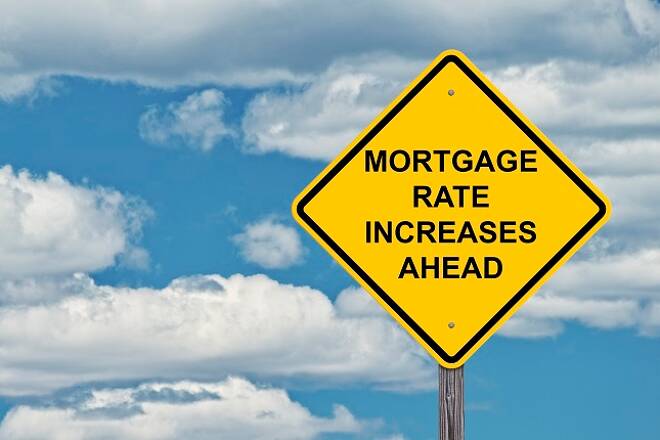Advertisement
Advertisement
U.S Mortgages – Rates Jump to Add more Pressure on the Real Estate Sector
By:
Mortgage rates are knocking on the door of 5% and it could be in the week ahead, following a hawkish FED last week.
Following last week’s downward move, mortgage rates rebounded in the week ending 8th November, with 30-year fixed surging by 11 basis point to a 7-year high 4.94%.
Economic data through the week was on the lighter side with a slightly softer non-manufacturing sector October PMI continuing to support a positive outlook towards the U.S economy, while the two main events of the week were the U.S mid-term election results on Wednesday and the FED monetary policy decision on Thursday.
With mortgage rates on an upward trajectory, labour market conditions and wage growth have certainly provided some solace, with a slowdown in house price growth also supporting those looking to get onto the property ladder, though the issue remains that the upward trend in rates over the last 12-months has caused prospective buyers to revise budgets, with a lack of inventories also weighing.
While higher mortgage rates have contributed to the slowdown in house price growth, price deceleration has been primarily concentrated in affluent coastal markets, according to Freddie Mac, with more affordable interior markets having yet to experience a slowdown in price growth, adding to the burden of rising mortgage rates on affordability.
Freddie Mac weekly average rates for new mortgages as of 8th November were quoted to be:
- 30-year fixed rate loan increased from 4.83% to 4.94% in the week, while up from 3.90% a year ago. The average fee remained unchanged at 0.5 points.
- 15-year fixed rates rose from 4.23% to 4.33% in the week, while up from 3.24% from a year ago. The average fee remained unchanged at 0.5 points.
- 5-year fixed rates increased from 4.04% to 4.14% in the week and up from last year’s 3.22%. The average fee held steady at 0.3 points.
Mortgage Bankers’ Association Rates for the week ending 2nd November were quoted to be:
- Average interest rates for 30-year fixed, backed by the FHA, increased from 5.08% to 5.15%, with points increasing from 0.62 to 0.64 (incl. origination fee) for 80% LTV loans.
- Average interest rates for 30-year fixed with conforming loan balances increased from 5.11 to 5.15, with points rising from 0.50 to 0.51 (incl. origination fee) for 80% LTV loans.
- Average 30-year rates for jumbo loan balances increased from 4.94% to 4.97%, with points falling from 0.28 to 0.27 (incl. origination fee) for 80% LTV loans.
Weekly figures released by the Mortgage bankers Association showed that the Market Composite Index, which is a measure of mortgage loan application volume, slide by 4% to its lowest level since Dec-14 in the week ending 7th November, following on from the previous week’s 2.5% fall, week-on-week.
The Refinance Index fell by 3%, in the week ending 7th November, following the previous week’s 4% slide, with the share of refinance mortgages falling from 39.4% to 39.1%.
The MBA noted that the upward trend in mortgage rates was attributed to better than expected nonfarm payroll figure and a jump in wage growth, with a 30-year fixed at 5.15% sitting at the highest level since Apr-10.
Both purchase and refinance activity slid, with the purchase index hitting its lowest level since 2016, reflecting the effect of inventory shortages and rising mortgage rates on home buying activity.
Last week, the MBA also released its delinquency numbers for the 3rd quarter:
- Delinquency rates of mortgage loans for one-to-four unit residential properties rose to a seasonally adjusted 4.47% of all loans outstanding at the end of the 3rd
- Quarter-on-quarter, the delinquency rate was up 11 basis points, while down 41 basis points from one year ago.
- The percentage of loans on which foreclosure actions were started fell by 1 basis point to 0.23%, its lowest level since the 4th quarter of 1985.
- Natural disasters affected delinquencies, with a number of hurricanes and tropical storms affecting state numbers.
Key findings from the MBA’s Quarterly National Delinquency Survey Included:
- All loan types saw mortgage delinquency rates rise, quarter-on-quarter, in the 3rd.
- Year-on-year, delinquencies were down across all loan types.
- The serious delinquency rates stood at 2.13%, the percentage of loans that are 90 days or more past due or in the process of foreclosure, down 17 basis points from the last quarter and down by 39 basis points from last year.
- The percentage of loans in the foreclosure process at the end of the 3rd quarter stood at 0.99%, down 6 basis points from the 2nd quarter and down by 24 basis points from one year ago, the foreclosure inventory rate sitting at its lowest level since 2nd quarter, 2006.
For the week ahead, it’s a relatively busy week on the data front, with key stats including October inflation numbers on Wednesday and retail sales, business inventories and manufacturing sector PMI numbers for November due out on Thursday, while upward pressure on yields following last week’s FOMC statement will also look to nudge mortgage rates ever close to 5%.
Outside the numbers, geo-political risk will play a hand in the direction of U.S Treasury yields, the dust yet to settle following the mid-terms on Wednesday and with Brexit and Italy’s budget also there to influence.
About the Author
Bob Masonauthor
With over 28 years of experience in the financial industry, Bob has worked with various global rating agencies and multinational banks. Currently he is covering currencies, commodities, alternative asset classes and global equities, focusing mostly on European and Asian markets.
Advertisement
